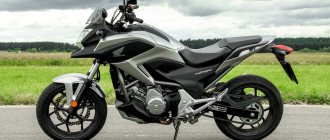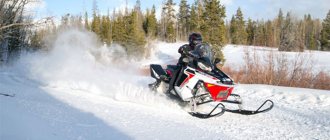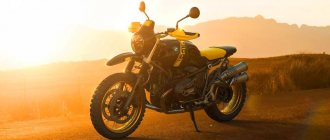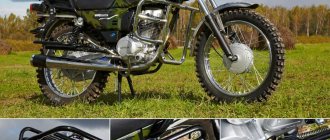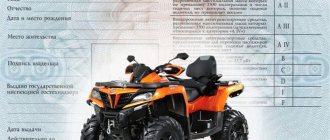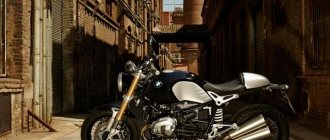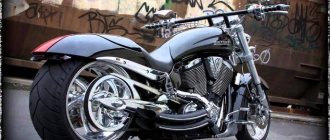Vyacheslav KITSIS, host of the “Two Wheels Club” section:
However, choosing a motorcycle from the “secondhand” category requires extreme caution. After all, if a breakdown of a used car usually entails only unforeseen repair costs, then for a motorcyclist a sudden malfunction is often fraught with a serious accident with unpredictable consequences. It is useless to ask the seller about the defects of the bike: maybe he will not lie outright, convincing that his product is in excellent condition, but he will not tell the whole truth about the motorcycle. This is the specificity of his work... It is much more useful to seek advice from an experienced motorcyclist. And without false modesty, I can call myself an expert in this matter - not only as the host of the “Two Wheels Club”, but also as a person who at one time worked in a used motorcycle dealership for many years and knows first-hand all the tricks of dealers.
So, when you go to choose such a “motorcycle,” you can take this issue of the newspaper with you and feel free to use our advice as a purchasing guide. It doesn't matter what brand and model we are talking about. I will try to protect you from the basic mistakes that await an inexperienced person when buying a used motorcycle. The main thing is not to buy the notorious pig in a poke. I dare to assure you that in the end this will save your nerves, money, and possibly your health and even your life.
Pedigree
WHERE IS THE MOTORCYCLE FROM? There are important nuances of choice associated with this. The main donor of “second-hand” motorcycles is Japan, with its endlessly old sludge, among which there are both outright junk and surprisingly well-preserved specimens. Quite large companies are now engaged in the import of used Japanese motorcycles. They bring both whole and damaged bikes, which they repair on their own.
Old motorcycles used in this island country often look unpresentable. The proximity of the salty ocean negatively affects, first of all, aluminum parts, which within ten years have time to “bloom” with corrosion pits. But the technical condition of the motorcycle may be close to ideal. And the mileage, as a rule, is low - unless, of course, the first owner was fond of traveling around the world.. More recent copies often look like new in appearance.
When purchasing a Japanese motorcycle, be sure to inquire whether this model was released only for the domestic market. In this case, there may be problems with spare parts.
Well-used motorcycles from Europe, on the contrary, can have a shiny appearance and... an engine in a pre-infarction state. Here the conversation is mainly about fast sportbikes. Keep in mind: if the odometer shows a modest number, then there is every reason to doubt its authenticity. In the countries of endless autobahns, God himself ordered, having opened the throttle “all the way” in one city, to close it only in another, where, it is possible, the place of work of the owner of the motorcycle is located - so he rushes back and forth every day. You have to be extremely careful not to buy a device with a worn-out engine, which, after prolonged use at high speeds, will consume as much oil as gasoline.
Residents of the United States are quite careless about their motorcycles, and the motorcycles that come to us from overseas can be very different both in the condition of the chassis and engine, and in appearance. A lot of emergency equipment is being brought from America. There it is forbidden to use a motorcycle after an accident, but in Russia no one cares: they repair it and move on.
With the exception of the iconic Harley and two or three other brands produced there under license, Japanese motorcycles come from the States. Including a lot of cross-country equipment. In the USA there are many strong cross-country racers of international level, so the fleet of motorcycles of both the riders themselves and motocross schools often changes. It is highly undesirable to run into a motorcycle “from under an athlete.” Despite the fresh plastic, which is used to replace the “combat” one before sale, such a motorcycle, as the athletes themselves put it, is very tired. Starting with the frame, which has withstood thousands of jumps, and ending with the engine, which has driven dozens of pistons...
A separate issue concerns foreign equipment sold by private individuals. Here I advise you to be especially careful and picky about the documents, if any. There are many stolen (both in our country and abroad) bikes offered through advertisements. If you have the slightest suspicion about the purity of the history of the copy you like, I advise you to refuse the purchase. Even if the motorcycle is in perfect condition, has no mileage and is sold inexpensively.
What's in the report
Our online service for checking the history of vehicles on the territory of the Russian Federation provides information about all vehicles registered in Russia. The finished report contains the following information about the motorcycle:
- basic technical characteristics of transport;
- information from PTS;
- history of registration actions;
- participation in an accident, indicating the degree of guilt of the owner and photographs from the scene of the accident;
- actual mileage;
- restrictions on registration actions;
- being hijacked;
- working in a taxi;
- fact of disposal;
- being on bail;
- a valid MTPL policy;
- passed maintenance;
- the amount of tax and the cost of compulsory motor liability insurance;
- fines.
You can see a sample report to see the importance of purchasing it.
When viewing advertisements for the sale of motorcycles, ask for information about the vehicle if it has a VIN or state number. This will help you buy legally clean vehicles that do not have serious technical flaws.
At first sight…
LET'S START the inspection with the appearance of the motorcycle. This is his calling card. I immediately want to believe that the inside of the car is as well maintained as the outside. After all, a careful owner not only washes and polishes his bike, but also changes the oil on time and does maintenance. However, we must not forget the old truth: not all that glitters is gold. (And if we have a used “European” in front of us, let’s not forget that behind a completely decent appearance there are often hidden “dead” chassis and engine.) Let’s take a closer look at the specimen we like. One paradox will help us with this: the more diligently the motorcycle is cleaned, the more clearly its flaws are visible. So…
The paint should ideally be “original”, without deep scratches, chips and severe abrasions, especially in the gas tank area (from the driver’s legs and stomach). If the motorcycle has been repainted, we give it a minus.
Let's dig deeper: why was it repainted? First of all, look for signs of a fall. They are different. The motorcycle can simply fall while standing on level ground (for example, the step has pushed through the asphalt melted by the hot sun). In such cases, the fairing (if it is a sportbike), headlight, mirrors, turn signals, wingtips, muffler and, if you are really unlucky, the gas tank are usually affected.
I call this fall cosmetic. It only spoils the appearance of the bike without causing damage to the chassis. The consequences are much worse when the motorcycle falls at speed.
Signs of such an accident remain on large parts (they, as a rule, try not to change them due to their high cost). This is primarily a muffler. Run your hand along its lower surface - if the motorcycle was laid on its side while in motion, you will immediately feel the roughness from the long scratches of the torn chrome. Carefully inspect the engine, especially the clutch cover on one side and the generator cover on the other. When falling at speed, their lower part probably hit the asphalt.
Don’t be too lazy to kneel down and look under the motorcycle: are the exhaust pipes crumpled, are there any signs of a blow to the engine crankcase cover...
Appearance is the calling card of a motorcycle. With a neat owner, it is usually equally well cared for inside and out.
Wheels and brakes
NOW about other important little things. It’s not a bad idea to spin the wheels and see if there is an elementary “eight”. Rock them from side to side - is there too much play in the bearings? At the same time, look at how worn the brake pads are (this can be seen if you look at the calipers from the front), as well as the brake discs themselves, and whether they are jamming in the pads. If yes, then the wheel turns with difficulty. The reason, most likely, is that the pistons in the calipers have soured (this happens when a motorcycle sits idle for a long time before being sold). The “disease” is extremely unpleasant: the pads will not return to place after braking, the brake discs will begin to heat up; It is also possible that the brake fluid may boil. As a result, the brakes disappear.
Most modern wheels are alloy, and the tires on them are usually tubeless. Carefully inspect the edge of the rim to see if there are any visible chips, dents or cracks. If they are, then there is a real risk that the wheel will slowly leak air along the deformed section of the rim, and it will not be possible to inflate it properly.
Spoke wheels are rare these days, more and more common on choppers and enduro motorcycles. For such wheels, you need to check whether all the spokes are in place and evenly tensioned (knock on them - the sound should be approximately the same). And again, look to see if there is an “eight”. Particularly affected by broken enduro wheels are those used in difficult, rough terrain conditions.
Prices
Successfully buying a motorcycle by accident, especially one you didn’t plan for, is a rare combination of circumstances. You can really buy it profitably when you prepare for it and know what you are looking for.
You need to choose a range of models that you are considering for yourself or the only one that has sunk into your soul. Next, you should monitor the prices. By the way, catalogs that are publicly available and updated every year can help with this. After evaluating the motorcycle itself, you need to look at the prices for spare parts and consumables. This can be very useful later when bargaining at the saddle.
Here we need to emphasize that buying an expensive or worn-out motorcycle with the last of your money is a bad idea. In both the first and second cases, giving away all your savings for the purchase, it turns out that you need to invest more. An expensive motorcycle has expensive maintenance, but a worn-out motorcycle starts to break down one by one.
A profitable purchase of a motorcycle is a purchase within your means and capabilities.
Tires
MODERN motorcycle tires begin to work at full strength (stick to the asphalt) only after they warm up while driving. The material from which they are made is similar to the rubber used for Formula I cars. On bikes older than five years (even if they have barely been ridden), you can see a thin web of cracks on the sidewalls of the tire - traces of a long stay in the open air. Such rubber becomes like plastic and stops holding the road. That is, you need to prepare to buy a new set of tires. A legitimate reason to ask for a discount.
If your tires look like new, it's more than likely that they've just been treated with an old tire care product. This trick is easy to expose. Run your finger over the tire. If it looks like it has been soaped up and there is a dirty, greasy mark left on your finger, then the fresh appearance of the wheels is a fiction. By the way, driving on such tires is extremely dangerous, especially in corners: its sidewalls remain slippery for a long time from the “chemicals”.
Via RSA
Another point that requires verification is the current MTPL agreement. If the seller drove the vehicle without insurance, this indicates his low responsibility for his obligations.
How to check:
- Go to the official RSA website.
- Enter the vehicle parameters and the date for which information is requested.
- Check the box to confirm the security of the input and click “Search”.
Of course, the lack of a policy is not a reason to refuse a good offer. Check with the seller for what reason he did not apply for compulsory motor liability insurance. Perhaps the vehicle has not been used, or the insurance coverage has recently expired.
Gas tank and carburetors
The gas tank can tell a LOT about the history of a motorcycle. Be sure to look into it, make sure that the walls are not covered with a coating of rust - this is a clear sign that the motorcycle spent a lot of time in the open air with an empty tank, perhaps even without a lid. If there is rust, you can be sure that it will settle in the carburetors (many used motorcycles have carburetors). This means you will have to spend money on an expensive service with complete disassembly, cleaning, replacement of locking needles, subsequent adjustment and synchronization. Carburetors (especially on motorcycles that have been standing for a long time, in particular those delivered from Japan) will have to be cleaned one way or another. This operation is inevitable, since gasoline, gradually evaporating from carburetors, leaves a fraction resembling cement in hardness at the bottom of the float chamber, jets, thin air and fuel channels. But a rusty tank! It is almost impossible to wash it from the inside. This means that you are doomed to forever clean the carburetors of your motorcycle.
The seller will foam at the mouth and insist that if you throw a handful of nuts into the tank, pour gasoline and shake it properly, it will become like new. Don't believe it. For some time after such treatment, the inside of the tank may shine, but the corrosion process will continue..
And by the appearance of the gas tank, you can indirectly judge whether the bike has been in an accident. If in the front part of the tank, to the right or left of the steering column, there are small, one might say, neat dents, then you know that when it fell, it cut off the limiters on the frame, and at the same time on the fork, it reached the gas tank and dented it. In this case, it is likely that not only the tank was damaged, but also the fork itself, the front wheel, and perhaps even the base of the motorcycle - the frame.
Checking through the AutoHistory service
The methods listed above for obtaining information about a motorcycle are effective, but require a lot of time. Some information is available only to the owner, and there is no guarantee that the data is current. The AutoHistory service is devoid of these disadvantages.
Why you should make a request through our service:
- Fast request processing. You will receive a report within 15 minutes.
- Complete information about the vehicle. The report includes all the details about the motorcycle, so you don't have to search multiple sites.
- The cost of the request is 199 rubles. The more reports you buy, the cheaper one report costs. This is beneficial for those who approach the purchase responsibly and choose a vehicle from several offers.
- The information is current as of the date of access. Databases are updated every half hour.
- The site works stably, without errors.
- The request can be sent at any time of the day.
- You can check the vehicle by VIN and state number.
How to check through the AutoHistory service:
- On the main page, enter the state number or VIN in the search bar and click “Check”.
- Wait until the request is processed and review the basic information.
- Click “Buy report”.
- Enter your email address and proceed to payment.
- Choose a convenient payment method.
- Pay and wait for the report.
Frame
KEEP IN MIND: no matter what modern slipway the damaged frame is corrected, no matter how much they assure you that this part has been brought into complete order, it will never be the same. If we compare a motorcycle with a living organism, then the frame should be likened to a spine. The spine must be healthy and, most importantly, smooth. From this point of view, it is necessary to consider the frame, carefully inspecting it from the steering column to the rear swingarm.
Frames can be made of steel, round or square pipes, or aluminum. In any case, on a “healthy” frame there should be no traces of impact, no dents, no welds where they are not supposed to be. It is more difficult to see traces of a fall on sportbikes - their frame is covered with a fairing. When in doubt, ask to remove the fairing, especially if you notice that its parts are held together by non-branded fasteners. It is likely that after the accident, the repaired and painted fairing was used to cover the damaged frame.
But it happens that no traces of an accident remain on the frame, but nevertheless its geometry is violated. I have a simple test for this. When the seller demonstrates the motorcycle in motion, ask him to slowly drive towards you several times. And, squatting down, look: are the wheels lying in the same plane? The method is primitive, but quite suitable if you don’t have a laser device at hand that will find all the base points of the running bike. If you have the slightest doubt, say thank you to the seller and go look for another motorcycle. You're not a kamikaze...
Front fork
THIS DETAIL also requires attention during inspection. It is convenient to check the fork on the motorcycle when it is standing on the center stand. Have someone push on the back of the bike or just sit in the passenger seat. When the front wheel begins to spin freely in the air, grab both legs of the fork as close to the bottom of the fork as possible and wiggle it. If the fork is heavily worn, you will immediately feel it by the beating of the feathers in the guide bushings.
In addition, the fork may dangle in the steering column (due, in all likelihood, to the fact that the upper and lower bearings have “run out”). This seemingly innocent play can turn into a tragedy on the highway. At a decent speed - usually well over a hundred - the front wheel suddenly begins to “walk” from side to side in an ascending amplitude. Most often this ends in a fall. Therefore, if you discover such a defect, be sure to bring it to the attention of the manager and agree either to carry out repairs before selling, or to receive an appropriate discount. But worn bearings must be replaced immediately.
On motorcycles that are not equipped with a center stand (such as sportbikes), it is more difficult to check the front fork. A well-equipped service center must have a special stand for this.
After you've held the chrome ends of the fork legs, look at your hands to see if there are any traces of oil on them? If there is, it means the seals are leaking and, as a result, the fork hydraulics may not work properly. And in addition, the oil, flowing down the feathers, will certainly end up on the brake pads. And oiled brakes have never brought happiness to anyone...
Transmission
There are three types of SHE on motorcycles. The first is a cardan drive (most often it can be found on heavy “neoclassics”, “touring” and “cruisers”). Such a transmission can only be checked on the go, in a test drive. To do this you will have to break the Rules and not wear a helmet. Listen to whether the final drive gears are whining in the rear axle (this can be heard already at speeds from 60 to 80 km/h). Ask the manager (or try it yourself, if you are entrusted with the steering wheel) to sharply increase and release the gas several times while driving: will there be unpleasant knocking noises - a sign of increased gaps in the splines and gears from a very long or improper operation of the transmission.
The second type of drive to the rear wheel is a chain. The condition of the chain drive is easier to determine. Grab the chain with two fingers where it fits onto the rear large sprocket, at its outermost point, and try to pull it back. If this succeeds, it means that the chain is very worn and must be replaced. The chain, which has exhausted its resource, begins to intensively gnaw on both sprockets - both front and rear. Eventually you will have to change them too.
The third drive option - a toothed belt - is quite rare, as a rule, on choppers that do not have high engine power and speed. Although I once had the opportunity to test a super-powerful “Boss Hoss V8” with a seven-liter engine from a “Chevrolet Tahoe”, in which a Kevlar belt served as a drive from the automatic transmission to the rear wheel. It is good because it requires virtually no maintenance. You just need to monitor its tension and avoid excessive contamination.
Electrodiagnostics
Not many motorcycle services can boast of modern equipment for diagnosing motorcycle electrical systems. We guarantee the accuracy, speed and reliability of the readings of our complexes.
Motorcycle electrical diagnostics include:
The cost of work is calculated based on time spent.
